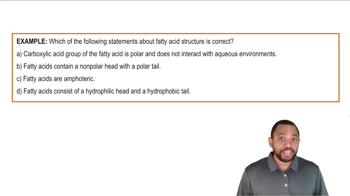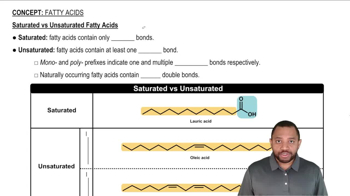Here are the essential concepts you must grasp in order to answer the question correctly.
Fatty Acid Structure
Fatty acids are carboxylic acids with long hydrocarbon chains. They consist of a hydrophilic (water-attracting) carboxyl group (-COOH) at one end and a hydrophobic (water-repelling) hydrocarbon tail. The length of the hydrocarbon chain and the presence of double bonds are key factors that differentiate saturated from unsaturated fatty acids.
Recommended video:
Saturated vs. Unsaturated Fatty Acids
Saturated fatty acids have no double bonds between carbon atoms in their hydrocarbon chains, resulting in a straight structure that allows them to pack closely together, typically making them solid at room temperature. In contrast, unsaturated fatty acids contain one or more double bonds, introducing kinks in their structure that prevent tight packing, usually making them liquid at room temperature.
Recommended video:
Physical Properties and Health Implications
The structural differences between saturated and unsaturated fatty acids lead to distinct physical properties and health implications. Saturated fats are often associated with higher cholesterol levels and increased risk of heart disease, while unsaturated fats, particularly polyunsaturated fats, are considered healthier and beneficial for heart health due to their ability to lower bad cholesterol levels.
Recommended video:
Physical Properties Concept
 Verified step by step guidance
Verified step by step guidance Verified Solution
Verified Solution



 2:0m
2:0m